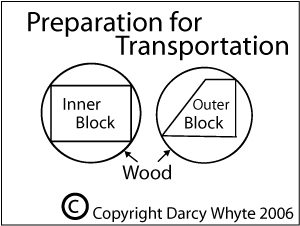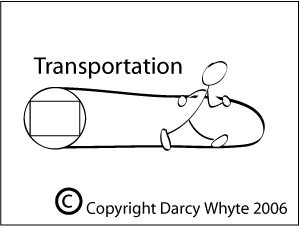Egyptian Pyramid: Only 100 People Lifting Stones
Did space people help build the great pyramids? No it was people and rope.
I devised an efficient way of lifting the blocks using just wood and ropes.
I’m not claiming it was done specifically this way but that the Egyptians were at least this efficient. Further that when you do the math the lifting trade wasn’t as daunting as engineers originally thought. I’m claiming the lifting workforce was only around 100 people.
The first thing to do is prepare the blocks for transportation and lifting. If wood is strapped to blocks, they become cylinders. This could have been done by strapping logs or making specially shaped forms to strap onto the blocks. Especially for the outer stones which were all very similar plus being the outer surface you don’t want to mark them. By contrast the inner blocks were random in size and it was not critical that they were all the same size.
Once the blocks are prepared, they can then be rolled along the ground or mile incline. A loop of rope could be placed in groves in the wood making it easy to roll the block. The puller may step on the rope to prevent it from slipping around the stone.
Another person may be needed to help steer the stone. Or perhaps two ropes with two people. They could steer by coordinating their work.
These stones are the same order of magnitude of weight as a car. And as we all know it is farily easy for one or two people to keep a car rolling. Even if there is a mild incline. I used to push start my car from inside my garage by pushing it up the incline towards the street by myself. I’d push it up the incline. Get in, hit the break, put it in reverse and then start it as it rolled backwards back down the incline (I used to back into my parking space).
Many people believe that they stacked up the inner stones of the great pyramid and then after the huge stepped structure was made they added the smooth angled stones on the outside. I suspect it didn’t happen in that order. I propose that they put the surface stones in (around the perimeter) for each layer. Then filled the layer with square stones for the inside of the pyramid. This would permit them to make use of a smooth surface during construction.
If you look a the Lifting diagram to the right you can see a suggested method of lifting the stones using ropes. This mechanism provides a 2:1 lifting advantage because of the block-and-tackle configuration of the rope and the stone. I figure that it would have taken only 7 or 8 men to lift one stone with this method (assuming around 150lb per person).
Further, this method could be used to bring people and supplies up and down the pyramid.
For this to work, the outer stones would be pre-cut to the correct angle.

A wooden jig could be used to make the outer stones. Then the stones could be lined up using a straight edge.
Perhaps they used a jig to pre-cut the stones. If they were well made then they could be put in place with a straight edge and string. Alignment along the sides could be done with a string and the alignment from top to bottom could have been done using straight edges. So the alignment of the entire structure would have been automatic.
I did some calculations for this method and it amounts to only the calories of about 9,000,000 Twinkies for the lifting trade.
If you assume that a person moves 16 tonnes of material per day, then it comes out to an unexpectedly small workforce to get the job done in 20 years. The 16 tonnes estimate is based on moving material with a shovel so a person can probably move a lot more than that.
You can see some of the details of my calculation from the presentation.
- Construction: 2589 B.C. 20 years.
- 2,300,000 blocks, 6.5 million tons (590,712 Socrates G. Taseos, 7,016,280? other sources vary).
- Average weigh 2.5 tons. None <2 tons. King’s Chamber blocks >9 tons. Average (5x8x12)
- Base/Height 754’x481′ (now 745’x449′).
- Slope 51 deg. 51 min, 201 steps
- Vol: (b²h)/3 = 91,152,065 ft³ =2,581,139 m³
- Mass: 5,955,000 tonnes = 11,910,000,000 lb
- Density: 131 lb/ft³ = 2g/cm³ (Sandstone 2g/cm³)
- Work: 1,432,177,500,000 ft lb (h/4 = 120.25′)
- Food: 463,895,064 kcal = 3,092,633 Twinkies
- Human: 2000 cal/day → 231948 person days
- 20 years at 10% efficiency → 317 (lifters)
- 10 years at 10% efficiency → 634 (lifters)
I used 2000 cal/day as the human caloric requirement. This is unrealistic as a laborer on a project like this would be much more. Like 6000-10,000 calories per day. So the workforce for the lifting trade is even smaller than these estimates.
So if you divide the workforce by three the 20 year version comes to around 100 people.
How about them apples!


